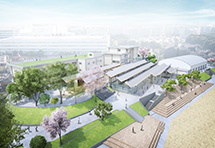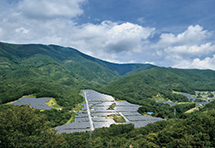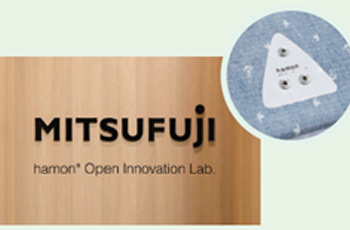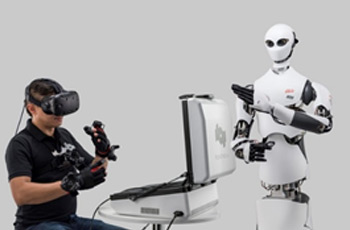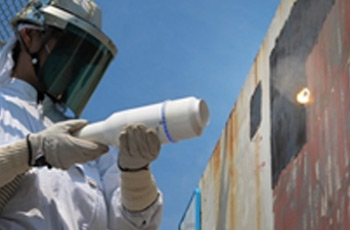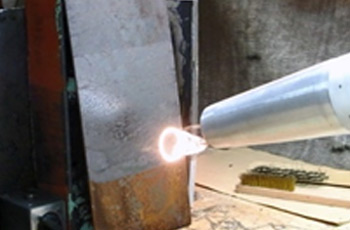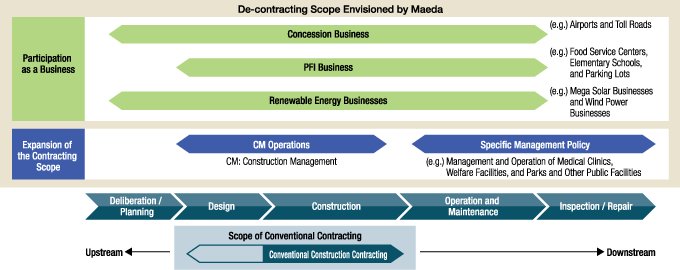

-
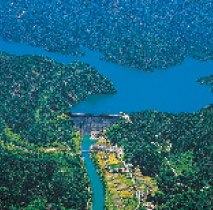 Completed in 1960Tagokura DamConcrete Gravity Dam
Completed in 1960Tagokura DamConcrete Gravity Dam -
 Breakthrough in 1983Seikan TunnelUndersea Tunnel
Breakthrough in 1983Seikan TunnelUndersea Tunnel -
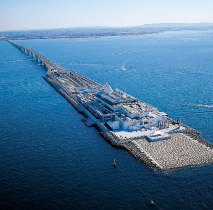 Opened to public in 1997Tokyo Bay Aqua-Line UmihotaruExcavation Shield
Opened to public in 1997Tokyo Bay Aqua-Line UmihotaruExcavation Shield -
 Completed in 2008THE TOKYO TOWERSHigh-rise Condominium
Completed in 2008THE TOKYO TOWERSHigh-rise Condominium -
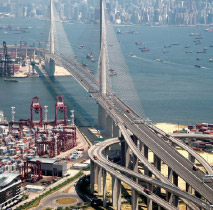 Completed in 2009Stonecutters BridgeCable-stayed Bridge
Completed in 2009Stonecutters BridgeCable-stayed Bridge -
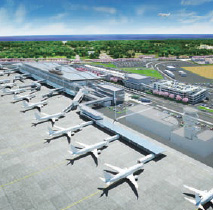 Full privatization completed in 2016Sendai International AirportDe-contracting
Full privatization completed in 2016Sendai International AirportDe-contracting
The No. 1 dam in the East, the No. 1 undersea tunnel in the World, and the No. 1 high-rise condominium in Japan...
Since its founding in 1919, Maeda has taken on challenges that respond to the needs of the time and accomplished “No. 1” in numerous areas.
As the company celebrated its 100th anniversary in 2019, we began a new challenge to become No. 1 by passing down and surpassing the legacy built up to today.
INFRASTRUCTURE
Underpinning the Lifeline
of People and Society
During the reconstruction and high growth period after the war, Maeda has played an important role essential to the growth of society. We have fostered growth as a company which exists to support the lifeline for the people and society by building dams that contribute to things from the stable supply of water and power to the prevention of water pollution while constructing infrastructure such as railways, tunnels and bridges that can offer efficient mobility and transportation to remote areas.
Civil Engineering Works in Mountainous Areas
1919
Matabee Maeda establishes Maeda Office under the Tobishima Gumi umbrella (founded on January 8, 1919)
See more
Electric Steel Manufacturing:
Order for Kiso Fukushima No.2 Hydroelectric Power Plant (Nagano) (First project after the founding)
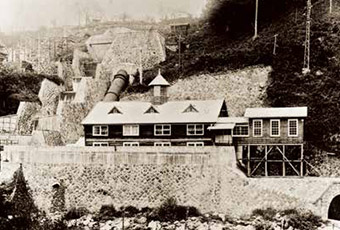
1921
Japanese Government Railways:
Order for Hokkaido Teshio Line railway roadbed construction (Hokkaido)
1922
Toshin Electric Power:
Order for Takase River No.2, 3, 4, and 5 Power Plants (Nagano)
See more
1944
Hokuriku Electric Power:
Order for the Asuwa River Power Plant (Fukui)
Construction was suspended for lack of materials and labor during the Pacific War but resumed in 1947.
1946
Tohoku Electric Power:
Order for Miyashita Power Plant (Fukushima)
Maeda Office reorganized as Maeda Corporation (Founded on November 6, 1946)
An Even Greater Large-scale Projects
1951
Teito Rapid Transit Authority:
Order for the Marunouchi Subway Line (Tokyo)
See more
1955
Electric Power Development:
Order for the Tagokura Dam (Fukushima)
See more
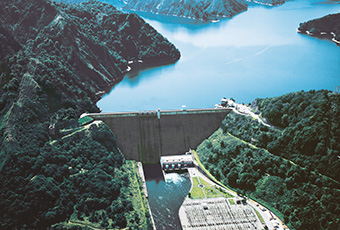
1956
Hokuriku Electric Power:
Order for Arimine Dam (Toyama)
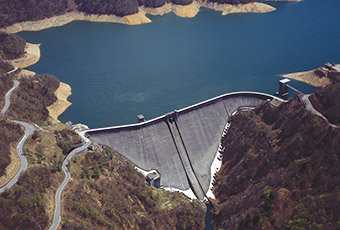
1958
Ichi Irrigation:
Order for the Shiroyama Tunnel (Aichi)
1960
Japanese National Railways:
Order for the Tokaido Shinkansen Kozu Section Construction (Kanagawa)
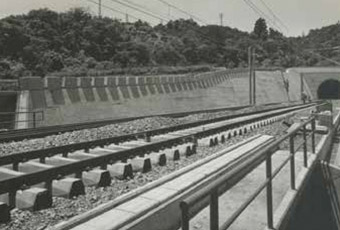
ADVANCEMENT
Contributing to
Urban Development
Maeda has expanded its businesses from civil engineering to, building works, supported the lifestyles of people and society, and continually contributed to urban development. Through the integration of constant perseverance and a high-level of technological capabilities, we have foster growth to reach a general construction company which today has 17 bases throughout Japan, 13 bases overseas and boosts more than 3,000 employees.
1960
Maeda Establishes the Building Department
See more
Housing and Urban Development Corporation Tokiwadaira Danchi (Chiba)
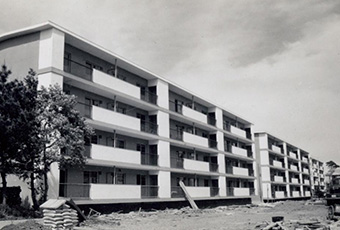
Tokiwadaira Danchi
1961
West Nippon Expressway:
Order for the Meishin Expressway Ibaraki Section Construction (Osaka)
1962
Ministry of Construction:
Order of the Tokyo Customs Government Office (Tokyo)
1963
British Hong Kong Government:
Order for the Kwai Chung Development Scheme Stage II (Hong Kong)
See more
1964
Imperial Household Agency:
Order for the Toukagakudo Imperial Concert Hall (Tokyo)
1965
Fukui Prefecture:
Order for the Fukui Prefectural Assembly Hall (Fukui)
Tokyo Electric Power Services:
Order for the Anegasaki Thermal Power Plant (Chiba)
1965
Thai Ministry of Transport:
Order for the Lampan-Chiang Mai Highway (Thailand)
1968
Maeda drafts the Integrity, Willingness, and Technology Corporate Motto
See more
1971
Tokyo Electric Power Company:
Order for Takase Dam (Nagano)
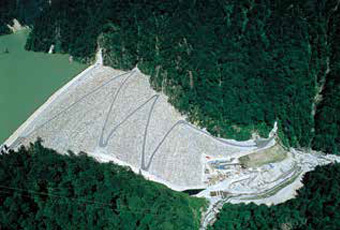
1972
Japan Railway Construction Public Corporation:
Order for the Seikan Tunnel Yoshioka construction (Hokkaido)
1974
Tokyo Electric Power Company:
Order for the Fukushima Daini Nuclear Power Plant (Fukushima)
1977
Japan Highway Public Corporation:
Order for the Kan-etsu Tunnel (Gunma)
1978
Honshu-Shikoku Bridge Authority:
Order for the Kita-Minami Bisan-Seto Bridges (Kagawa)
1980
Airports of Thailand:
Order for an expansion to the Bangkok International Airport (Thailand)
1984
Expressway Authority of Thailand:
Order for the Dao Kanong-Port Expressway (Thailand)
1984
Ushiku City:
Order for type-1 urban redevelopment of the Ushiku Station West Exit area(Ibaraki)
1985
New Urban Life Holdings:
Order for Hikarigaoka IMA (Tokyo)
See more
1987
Ministry of Construction:
Order for the Unazuki Dam (Toyama)
1988
Tokyo Electric Power Company:
Order for the Kashiwazaki-Kariwa Nuclear Power Plant (Niigata)
1989
Trans-Tokyo Bay Highway Corporation:
Order for the Tokyo Bay Aqua-Line Expressway for the Kisarazu artificial island Umihotaru (Chiba)

1989
Daikyo:
Order for Lions Station Tower Higashi-Sapporo (Hokkaido)
1990
Nakagawa Special Steel:
Order for Tennouzu Central Tower (Tokyo)
1991
Fukuoka Daiei:
Order for Fukuoka Dome (Fukuoka)
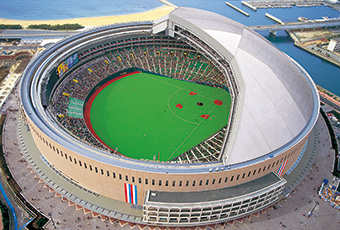
1992
Maeda Corporation:
Order for Hikarigaoka J.CITY (Tokyo)
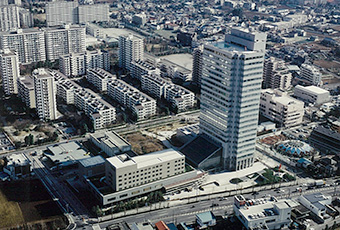
1992
British Hong Kong Government:
Order for the Kap Shui Mun Bridge and the Ma Wan Viaduct (Hong Kong)
Trans-Tokyo Bay Highway Corporation:
Order for construction of the Kisarazu central tunnel for the Tokyo Bay Aqua-Line Expressway (Chiba)
1994
Tokyo Metropolitan Government:
Order for the Sumida District Incineration Plant (Tokyo)
1995
British Hong Kong Government:
Order for the Hong Kong International Airport passenger terminal building (Hong Kong)
with Diversity
1996
Kitakyushu City:
Order for the Kitakyushu Media Dome (Fukuoka)
1996
Tokyo Electric Power Company:
Order for the Minamiaiki Dam (Nagano)
1998
Urban Renewal Association of Japan:
Order for type-1 urban redevelopment of the west district of Shin-Koyasu Station(Kanagawa)
SUSTAINABILITY
Supporting
Sustainable Lifestyles
New Construction Services
2000
Chiba City:
Order for a measurement certification complex at the Chiba Consumer Affairs Center (Chiba)
Maeda enters the retail business (Naoshiya Matabee opens in 2001)
2000
Urban Renewal Association of Japan:
Order for type-1 urban redevelopment of the Muromachi 1-chome District (Fukuoka)
Mitsubishi Estate:
Order for M.M.TOWERS 21 (Kanagawa)
See more
2003
Urban Renewal Association of Japan:
Order for type-1 urban redevelopment of the southern district in front of the Machiya Station (Tokyo)
2004
Hong Kong Special Administrative Region Government:
Order for Stonecutters Cable-stayed Bridge (Hong Kong)
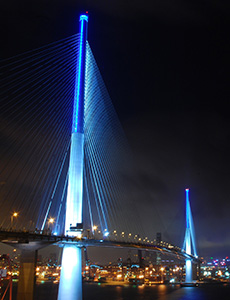
2004
Kachiroku Redevelopment:
Order for THE TOKYO TOWERS Kachidoki redevelopment project (Tokyo)

2005
Ministry of Land, Infrastructure, Transport and Tourism:
Order for the D runway at Haneda Tokyo International Airport (Tokyo)
2006
Department of Rapid Transit Systems, Taipei City Government:
Order for the CG590A construction of the Taipei Metro Songshan–Xindian Line (Taipei)
2007
Ceylon Electricity Board:
Order for the Upper Kotmale Hydro Power Plant (Sri Lanka)
2010
Maeda advocates Environmental Management No.1
2011
Urban Renewal Association of Japan:
Order for type-1 urban redevelopment of the Iidabashi Station West Exit area (Tokyo)
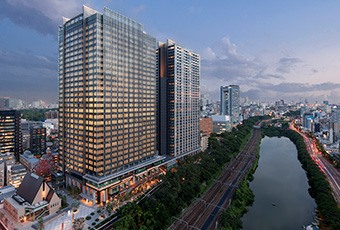
2013
Maeda starts de-contracting business
See more
2013
Maeda Corporation:
Start of electric sales from the Tsukuba Solar Power Plant (Ibaraki)
See more
2013
Urban Renewal Association of Japan:
Order for BIG FRONT Hiroshima (Hiroshima)
Sumita Town:
Order for the new Sumita Town Office (Iwate)
See more
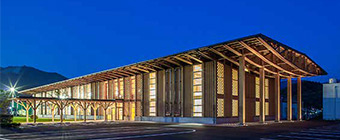
2014
Ho Chi Minh City Metro:
Order for a Ho Chi Minh subway tunnel (Vietnam)
2015
Special Purpose Company:
Start of electric power sales from the Goyozan Solar Power Plant (Iwate)
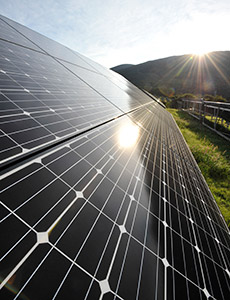
2015
Sumitomo Realty & Development:
Order for the (Tentative) Ariake Kita 3-1 District (3-1-A Block) New Construction Project (Tokyo)
2016
Maeda advocates CSV Management No.1
2016
Miyagi Prefecture:
Start of management for the Sendai International Airport (Concession; Miyagi)
See more
Aichi Prefecture:
Start of management for the Aichi Prefectural Toll Road (Aichi)
2017
Sumitomo Realty & Development:
Order for the (Tentative) Ariake Kita 3-1 District (B-2 Block/C-Block Parking Structure) New Construction Project (Tokyo)
2018
Mitsui Fudosan Residential and nine other companies:
Order for the construction of 5-5 Area building for the Type-I Urban Redevelopment Project in the West Harumi 5-Chome District (Tentative) (Tokyo)
2019
Special Purpose Company:
Start of electric power sales from Happo Wind Farm (Akita)
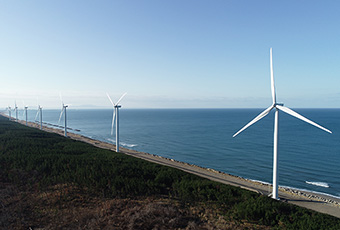
Aichi Prefecture:
Tentative start of management for the Aichi Sky Expo International Exhibition Center (Concession; Aichi)
CSV Management Platform: ICI*1 Lab to Resolve Social Issues via Open Innovation
Maeda has advocated CSV management as an important management philosophy since 2016. This management philosophy will allow the company to work and resolve a variety of social issues as a comprehensive infrastructure service company. Our driving force is the cultivation of technology and expertise in construction. Maeda opened the ICI Innovation Center in Toride City, Ibaraki as a base to further advance engineering capabilities and create new value.
The ICI Lab that opened first in December 2018 has three platform functions—gathering place, knowledge base, and capital platform—to realize innovative technological development and new businesses. As a gathering place, the ICI Lab offers a wide range of the latest infrastructure testing facilities and leading-edge offices. As a knowledge base, the ICI Lab supports innovation by bringing in outside experts in a variety of fields ranging from technology and intellectual property to start-ups, management and culture. As a capital platform, the ICI Lab runs MAEDA SII*2 to support venture companies financially which are struggling to raise capital from the market.
Maeda has grown and propelled the ICI Lab together with its collaborative partners and positioned it as a CSV management platform to resolve various social issues through open innovation.
*1 ICI: Incubation × Cultivation × Innovation
*2 SII: Social Impact Investment
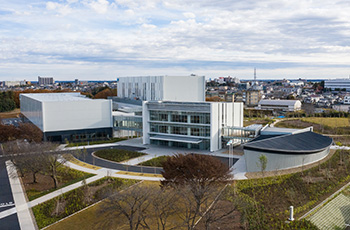
Overview of ICI Lab
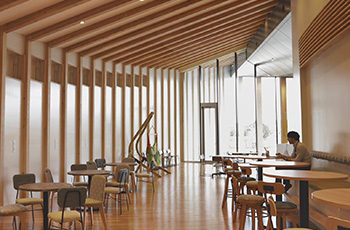
Nest Wing Guest Area
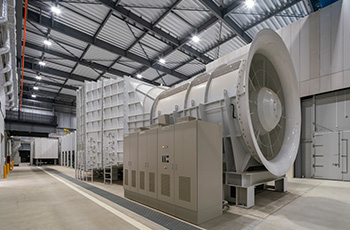
Wind Environmental Testing Equipment
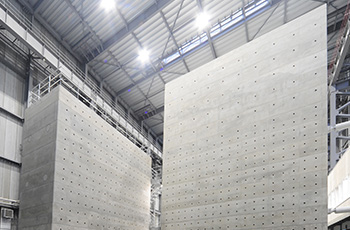
Reaction Wall and Reaction Slab
Nurturing Talent: ICI Human Resources Development Center
The ICI Human Resources Development Center will open after the ICI Lab in the fall of 2019 for the purpose of human resources education. We renovated and refurbished a closed elementary school with earthquake resistance technology. The ICI Human Resources Development Center is made up of accommodations wing where 170 people can stay and hold workshops as well as a multi-purpose seminar wing with a capacity of 200 people. The Center serves as a place for development and interaction of human resources who can contribute to new value creation through a network that brings together culture and the arts, such as local municipalities, universities, companies and residents while the ICI Lab aims to integrate venture companies, society, and economy through a network of knowledge.
The use of a site which was formerly an elementary school also aimed to become a new model project for the revitalization in which public facilities no longer in use are renewed as the closing of elementary and junior high schools built during periods of high economic growth becomes a social issue.
The ICI Innovation Center is a theme park that creates a future where people gather with the excitement of ambition. Maeda will resolve social issues through innovation brought about by a place to talk about, learn and put into practice the dreams of all people as it continues to persevere in a goal to be the best in CSV management.

Exterior of ICI Human Resources
Development Center

Shutdown Toride City Hakusan-nishi
Elementary School
Interior of ICI Human Resources
Development Center
Anticipating the NEXT100 with the De-contracting Business
After celebrating its 100th anniversary, the goal of Maeda in the next century is to innovate society and infrastructure as a comprehensive infrastructure service company. Our initial endeavor in our challenge to combine contracting and de-contracting as well as integrate engineering capabilities and new construction services was the renewable energy business.
In 2013, we first began operation of a solar power generation plant in Tsukuba City, Ibaraki. In 2015, Goyozan Solar Power Plant then went into full operation and began electric power sales. Ofunato City in Iwate Prefecture started this business as an earthquake reconstruction project by way of public invitation. Maeda proposed a plan to minimize the load on the natural environment through construction that takes advantage of the land in its natural state to win the bid. This project is realizing added value for the local community as a renewable energy business for local production and consumption by the community.
In summary, the pillar of de-contracting is concession business, which utilizes the engineering capability that has been strengthened over the years as the core, covers all areas of business from the upstream such as investment and development to the downstream such as operation and maintenance.
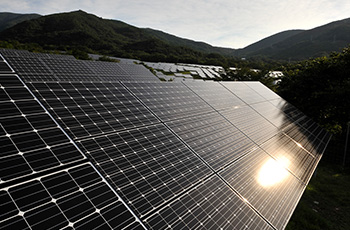
Goyozan Solar Power Plant
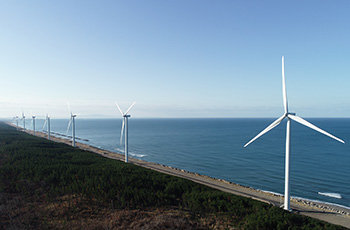
Happo Wind Farm
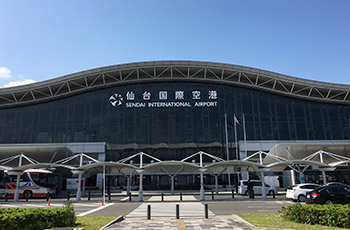
Sendai International Airport

Aichi Prefectural Toll Road
Revitalizing Regions and Resolving Other Social Issues
The Sendai International Airport was the first concession project that Maeda was involved. In July 2016, the project began as a joint venture between companies from a variety of industries including Maeda. As a construction company, Maeda proposed not only infrastructure and equipment but also management aimed at making sustainable vitalization and growth in anticipation of the future for the airport and city come true.
In addition, the consortium represented by Maeda was given the first refusal right for the concession for the Aichi Prefectural Toll Road which began operation in October 2016. We of course ran the project by prioritizing safety and security of the people using the road above all else, but we are also managing the road in a way that contributes to regional revitalization and development, such as branding and improving parking areas.
The Aichi Prefectural Toll Road will have a synergistic effect with the Aichi Sky Expo, the fourth largest international exhibition center in Japan which will open for business in September 2019, and lead to the development of industry in the surrounding regions.
This concession business rejuvenates the local community and resolves various social issues. This is the future Maeda envisions as a comprehensive infrastructure service company.
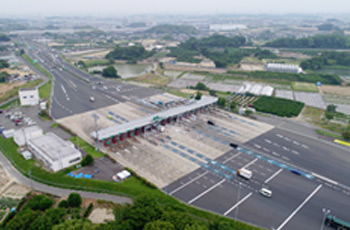
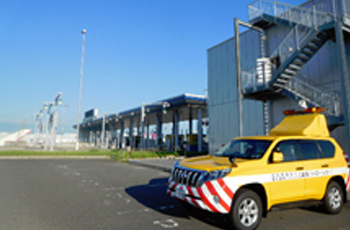
Aichi Prefectural Toll Road

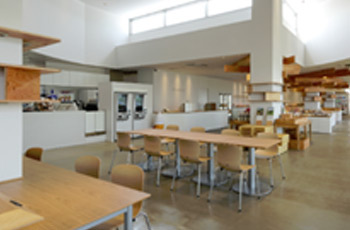
Agui Parking Area, Aichi Prefectural Toll Road

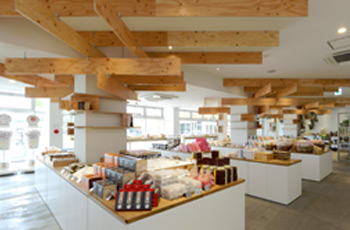
Obu Parking Area, Aichi Prefectural Toll Road
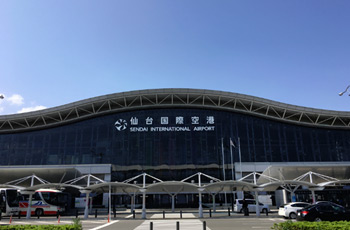
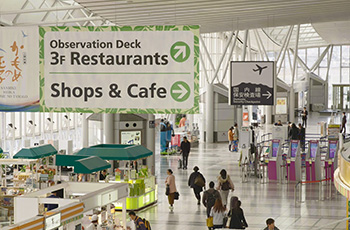
Sendai International Airport
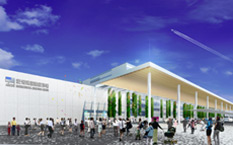
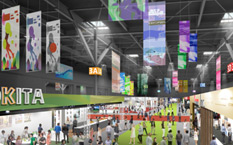
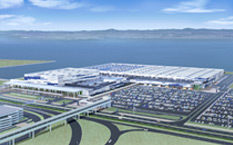
Aichi Sky Expo
Starting with Construction of Hydroelectric Power Plant
Our founder, Matabee Maeda, passed through the Tobishima Gumi gate with the desire to pursue a career in civil engineering business. Matabee founded Maeda Office under Tobishima Gumi in Kowashozu, Fukui on January 8, 1919. This was the beginning of 100 years of history at Maeda. The first project ordered to this firm was the Kiso Fukushima No.2 hydroelectric power plant built along the Otaki River that flows into the Kiso River in Nagano Prefecture. Maeda Office took on the challenge of this new construction with the effort of a team of less than five people. Only the outlets and the foundation remain today to evoke a picture of the structure from that time.
Matabee engaged in the work with integrity according to his philosophy that business mirrors the personalities of the people concerned. This philosophy has a relationship with our corporate philosophy today—Gaining Customers’ Trust by Doing a Good Job. Even after a century has passed, the universal approach forged by Matabee lives on unchanged even today.
-

Kiso Fukushima No.2 Hydroelectric Power Plant (Nagano)
The Roots of Maeda: Takase River Power Plants
The next project undertaken by the firm was the construction of four conduit-type power plants in the Takase River Valley in the Northern Alps. The steep mountains, brittle rocks, bursting hot springs, and winter cold and snow harsh enough to split stone. The difficult construction started by first preparing roads in severe climate conditions said to even break the will of mountain animals. As many businesses flinched at these conditions, Matabee Maeda took the lead of his team, put the fate of his company on line, and saw the project to fruition.
One of our clients spoke of the sincerity of Matabee at that time. Nobuteru Mori (founder of Showa Denko) praised him remarking, “The resolve to conquer and carry out what those who have come before thought impossible demonstrates profound character able to move the heavens.” The Takase River Power Plant project which earned immense trust from customers and fostered strong bonds among the Maeda team was really an epoch-making construction work that may be the origin of Maeda, which put our founding philosophy in shape.
New Challenges in Urban Engineering
Maeda heightened the trust and expectations from society through its track record as the leading company in dam construction. We expanded our business regions from the valleys of mountains to the cityscape with the technology and experience cultivated in many difficult dam construction projects. Our first surmountable urban civil engineering project started with the construction of the Teito Rapid Transit Authority Marunouchi Subway Line in 1951. This success brought contracts to service the railways and roads that connect major cities, such as the Tokaido Shinkansen Kozu construction project and the Meishin Expressway Ibaraki construction project.
In addition, Maeda dramatically helped to reduce the time to travel among the island nation of Japanese archipelago from south to north, such as connecting Honshu and Hokkaido via the Seikan Tunnel, which has the longest and deepest undersea portion in the world, and Honshu and Shikoku via the Great Seto Bridge. As part of the construction of the Tokyo Bay Aqua-Line that connects Kawasaki and Chiba that opened in 1997, we established automated excavation and automated segment assembly technology to use under the sea through the largest shield in the world. In this way, Maeda has taken part in many very difficult national projects and contributed to building the transportation network of Japan that serves as the foundation for high economic growth.
-
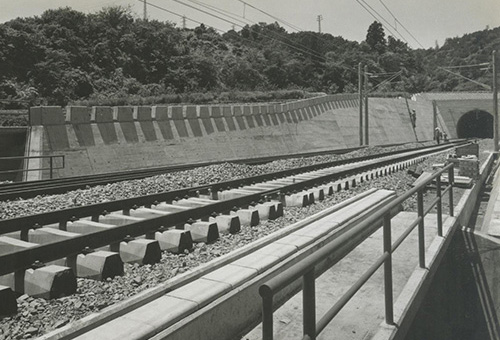
Tokaido Shinkansen Kozu Section Construction (Kanagawa)
-
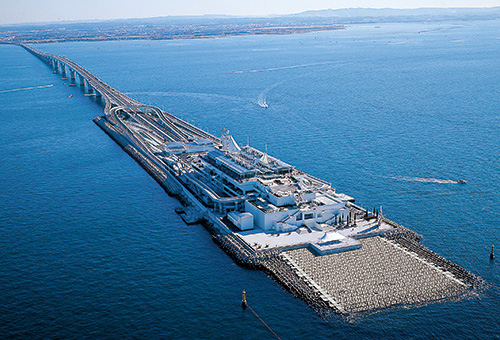
Trans-Tokyo Bay Highway [Tokyo Bay Aqua-Line] (Chiba)
Becoming the Leading Company of Dam Construction
Matabee Maeda continued to take on challenges in unprecedented large-scale dam construction in a severe social environment met by the Showa Depression and war. Maeda Corporation of today was founded by restructuring the Maeda Office on November 6, 1946, just after the end of the World War II. In 1955, Maeda undertook the construction of the Tagokura Dam upstream in the Tadami River of Fukushima Prefecture planned in preparation for emergency power.
The Tagokura Dam was a massive 380,000 kW dam project that outmatched the Sakuma Dam, which was built during that same period. This project was the envy of competitors and the proving grounds for Matabee Maeda II, who took the reins of the company as President. Maeda received the order thanks to the hard work of the entire company. We completed the concrete gravity dam at a scale said to be the largest in East Asia at the time. Many construction methods and records were established as firsts in Japan during this construction. Thereafter, in 1971, we undertook the Takase Dam, which was to be the largest rock-fill dam for pumped-storage hydroelectric power in East Asia. These projects are how Maeda built and secured a foothold as the leading company in dam construction.
-
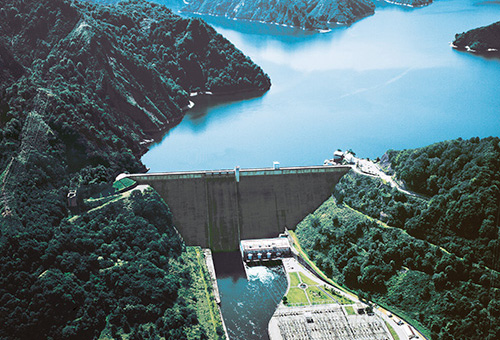
Tagokura Dam (Fukushima)
-
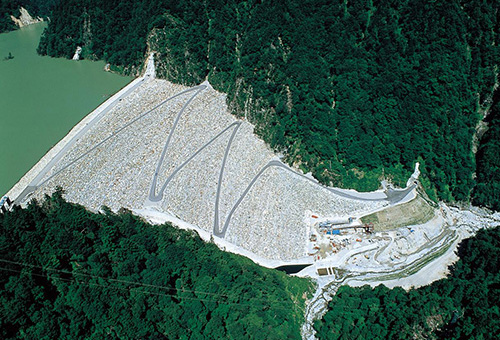
Takase Dam (Nagano)
-

Takase Dam during construction
Establishing a Building Department to Enter into Building Works Market
Maeda, often known for its excellence in civil engineering, proved itself by accumulating wealth of achievements. This history further accelerated expansion into the building works market. The first building project was the TEPCO Power Grid Toyama Electrical Substation. Our construction business that started with projects such as dam control buildings associated with civil engineering projects entered full swing with the establishment of the Building Department in 1960. In that same year, Maeda received an order for the Tokiwadaira Danchi (housing complex), a large-scale construction project from the Housing and Urban Development Corporation. Thereafter, we grew into an enterprise entrusted with all forms of urban development in addition to urban engineering construction from building the Tokyo Customs Government Office to constructing the Fukui Prefectural Assembly Hall, the Anegasaki Thermal Power Plant and the Toukagakudo Imperial Concert Hall.
-
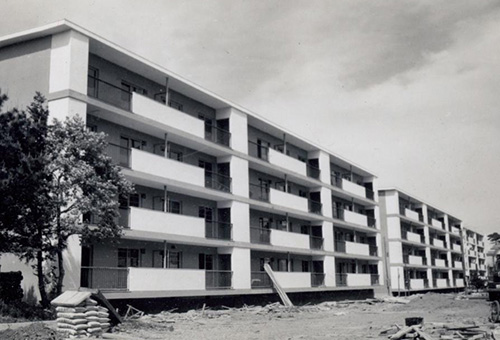
Housing and Urban Development Corporation Tokiwadaira Danchi (Chiba)
Maeda Technology Expanding Worldwide
The Maeda technology refined in Japan has received high praise even overseas. We expanded to Hong Kong in 1963 with our first overseas construction contract after the war. Maeda took part in structures indispensable to the local region one after another from the Kwai Chung Development Scheme Stage II Project to the Hong Kong International Airport, which was praised as the best airport in the world, and the Kap Shui Mun Bridge, which is used as a picture on one of the currency notes of Hong Kong. Our greatest accomplishment was the 1,596-meter-long Stonecutters Bridge which straddles the Rambler Channel. This project was completed in 2009 and supports the city as a pivotal social infrastructure of Hong Kong and as the largest suspension bridge in the world.
In Thailand, Maeda was the first Japanese organization to participate in the Asian Highway Network, the largest post-war highway plan laid out by the United Nations. We were in charge of the construction for the Lampan-Chiang Mai Highway that began in 1965. In addition, business expanded toward private projects after the expansion of the Bangkok International Airport and construction of the Dao Kanong-Port Expressway. In Vietnam, Maeda began with the construction of the Dami Hydropower Plant before pushing forward with the current construction of subway tunnels in Ho Chi Minh City. These accomplishments spread the trust earned in the civil engineering business of Maeda to the world stage.
-

Lampan-Chiang Mai Highway (Thailand)
-
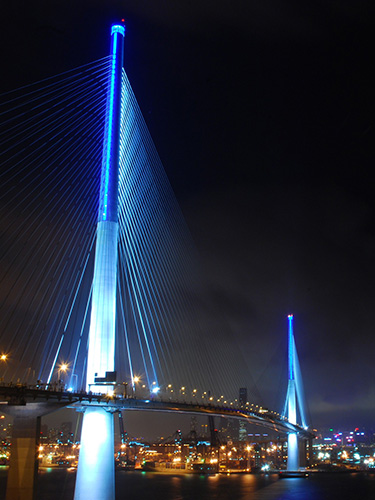
Stonecutters Bridge (Hong Kong)
Defining the Corporate Motto: Integrity, Willingness, and Technology
In 1968, Maeda formulated the corporate motto composed of Integrity, Willingness and Technology. Our corporate motto finds its origins in words spoken by Matabee Maeda on a daily basis: “Lead by example and take command with responsibility and passion in everything guided by the principles of integrity, willingness and technology.”
Focusing only on profit prevents the company from continuing. Only when the company has integrity and interacts with clients, will the business last and develop. (Citation from Integrity)
Work, it requires a strong self-discipline. Confidence that we are the best in technology and willingness to push ourselves to overcome difficulties. Willingness to work strengthens our minds and is indispensable to life. (Citation from Willingness)
We are strongly hoping that our workmanship could be identified that the work was done by Maeda at a glance. It is our technology that others want to learn from Maeda and not that Maeda has learned from others. This is our advantage. (Citation from Technology)
Integrity is the best of the three words from our corporate motto to describe the spirit of our founder. Even as our corporate motto reaches just shy of 50 years since its inception and the company celebrates its 100th anniversary, we are passing down this will to the future.
Expanding the Private Construction Field
The construction business that began in the public sector fully jumped into the private sector in the 1980s. Maeda expanded into factories, apartment housing and commercial facilities, such as Hikarigaoka IMA and the Ushiku Station West Area Urban Redevelopment Project. In 1986, we undertook development of high-rise, RC buildings before completing a review by the High-Rise Steel Reinforced Concrete Structural Technology Committee of the Building Center of Japan two years later. During this time, we established structural design methods, material performance assessment methods and construction methods unique to Maeda.
In 1991, we completed Lions Station Tower Higashi-Sapporo, the first 21-story high-rise, RC condominium for Maeda. Thereafter, we continued to take on challenges in construction that included the Tennouzu Central Tower, J.CITY skyscraper in Hikarigaoka and the Fukuoka Dome, which utilizes Japan’s first retractable roof.
-

Hikarigaoka J.CITY (Tokyo)
-

Fukuoka Dome [currently, Fukuoka Yafuoku! Dome] (Fukuoka)
Taking on the Challenge of Japan’s Highest High-rise Structure
Maeda had furthered development of RC structural design and construction technology to grow into the next stage of the company in the 21st century. We built the M.M. TOWERS, a 100-meter tall high-rise condominium equipped with seismic isolation in the Yokohama Minatomirai district in 2003. As a Kachidoki redevelopment project in 2008, we completed THE TOKYO TOWERS, 200-meter tall twin towers which are the highest high-rise buildings in Japan. We established the MARC-H design and construction system for high-rise RC multi-dwelling complexes while repeatedly proving ourselves in numerous projects. Maeda has continually brought high-quality, high-durability, high-rise condominiums into reality thanks to the rationalization of construction by transitioning to primary PCa structures.
Park Court Chiyoda Fujimi The Tower completed in 2014 is a project that embodies all of the technology in PCa construction compiled at Maeda. This venture transformed an area in which Maeda had been conducting business since its start in the Showa period as a district redevelopment project at Iidabashi Station West Exit Area. The Iidabashi Sakura Park district today includes the office wing of Iidabashi Grand Bloom where Maeda head office is also located and the Sakura Terrace commercial area. The area has been successful as an urban development project that melts seamlessly into the region, which is the goal of Maeda.
-
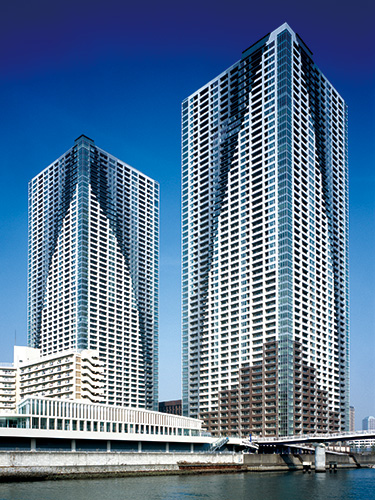
THE TOKYO TOWERS (Tokyo)
-
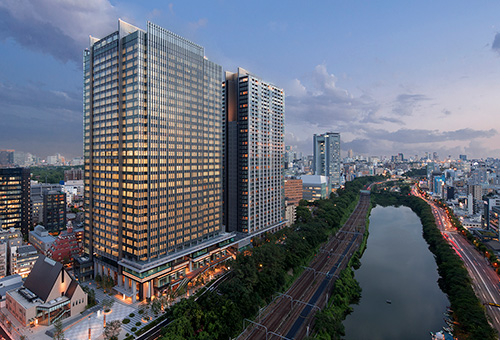
Iidabashi Station West Exit Area Redevelopment
Transitioning from a Contract-only Construction Service
The economic stagnation sparked at the end of the 20th century in Europe and America greatly impacted the construction industry. This economic wave hit even Japan like never before in the 21st century to bring about a generation today where a company can no longer exist with conventional business models. In the times to come, Maeda has set its sights on the concession business in which it has a proven track record in Europe to exist as an organization continually providing value to society and supporting lifestyles.
We will turn our trajectory from the conventional contract-only business model as demand for new construction dwindles while the demand for maintenance and management of existing structures booms. Surpassing the conventional range of contracting such as building of public facilities, Maeda will also become involved in maintenance and management operations. The construction industry will be tasked with everything from the upstream to the downstream from deliberation and planning to design, construction, operation, maintenance, inspections and repairs. Maeda began on its path toward de-contracting in the form of a future construction company.
Finding Solutions to Environmental Problems
Maeda cut its teeth on the renewable energy business as an enterprise pushing toward de-contracting. As the world faces climate change issues caused by global warming, Maeda advocates Environmental Management No.1 and engages in initiatives with true value. In 2013, we first began selling electricity from a solar power plant with a maximum output of 2 MW in Tsukuba City, Ibaraki. In Ofunato City, Iwate, we have been contributing to the region in reconstruction projects for areas afflicted by the earthquake, which started with electric power sales in 2015 from the Goyozan Solar Power Plant that has a maximum output of 18 MW. Furthermore, we are steadily advancing the renewable energy power generation business, such as the Happo Wind Farm with a maximum output of 20 MW that began operation in Happo-cho, Akita in 2019 and the Yasuoka offshore wind power generation project with a maximum output of 60 MW that is planned offshore in Shimonoseki, Yamaguchi.
-
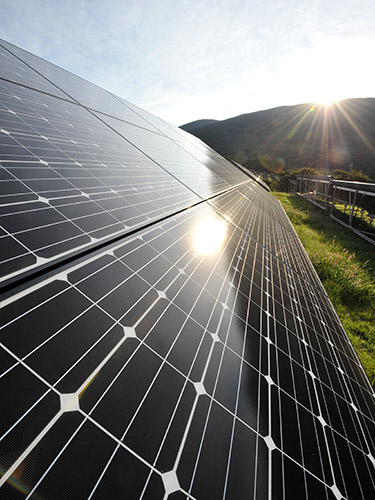
Goyozan Solar Power Plant (Iwate)
-
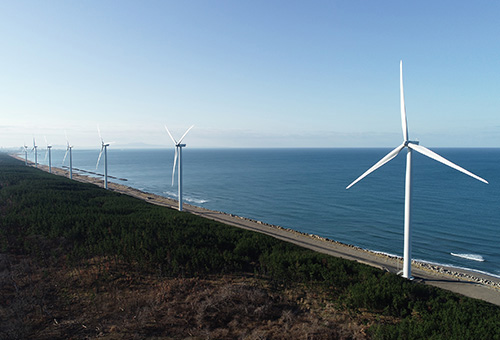
Happo Wind Farm (Akita)
Technological Development Giving Rise to Future Urban Development
Our work in the field of high-rise RC buildings and other multi-dwelling complexes propelled Maeda to become the leading company in the industry. However, our vision is not limited to raising these buildings. Our vision leverages the construction technology that we have cultivated in the last century up until now to create future urban developments.
For example, we used as much wood as possible from the town of Sumita, which hopes to offer the best forests and forestry in Japan, for the new Sumita Town Office in Iwate Prefecture in 2014. In addition to revitalizing local forestry, the open construction site engaged in work in collaboration with Sumita craftspersons and local construction companies. This model case of a wooden public facility was able to provide value to the local community. The structures that we are involved offer value to each of the local communities and vitalize the economy and lifestyles of people. We envision a company which will become the leader in this type of future urban development.
-
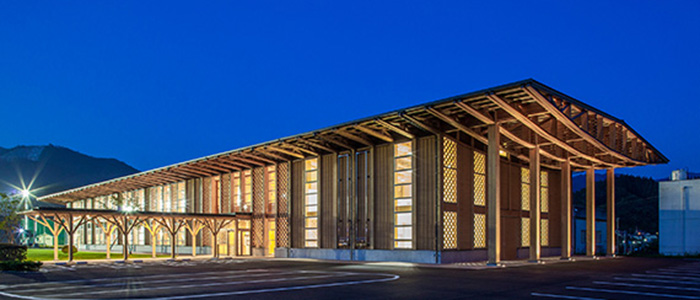
New Iwate Prefecture Sumita Town Office (Iwate)
-

-
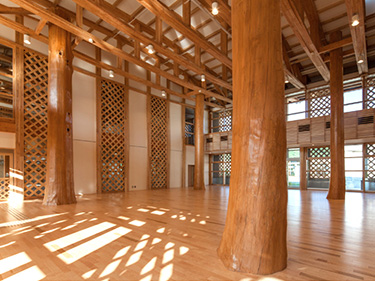
Polished Symbolic Wood Donated by the Townspeople
Resolving Social Issues and Fostering Sustainable Growth
The dedicated management business of Sendai International Airport was our first concession project in Japan. Maeda acquired the management rights in a consortium of multiple other companies and started private long-term management in 2016. In addition, we furthered the maintenance, management and renovations of the route 8 prefectural toll road with the Aichi Prefectural Toll Road concession that began in October of the same year. Moreover, we are also steadily expanding a de-contracting business model that encourages regional revitalization, such as the concession management of the Aichi Sky Expo (Aichi International Exhibition Center), which will open in September 2019.
Maeda has passed down a corporate philosophy to “Gain Customers’ Trust by Doing a Good Job,” which has remained unchanged in the century of perseverance since its founding by Matabee Maeda in 1919. We aim to become the best CSV management company able to resolve various social issues through business and support sustainable lifestyles. We are already engaged in a new Maeda challenge (Change!) for the next century.
-
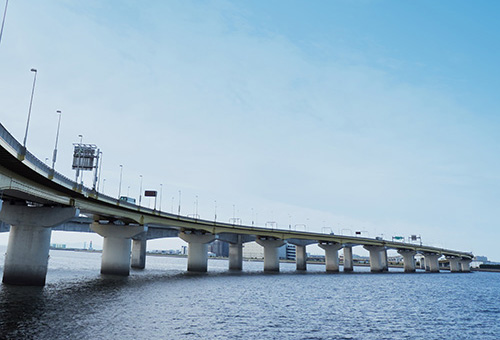
Aichi Prefectural Toll Road (Aichi)






